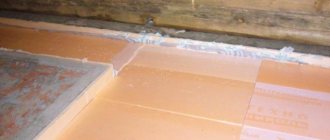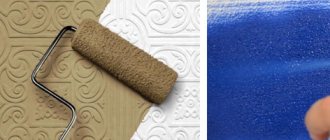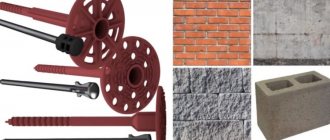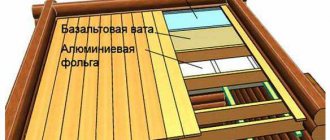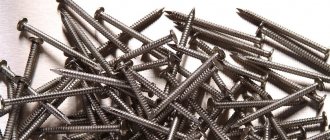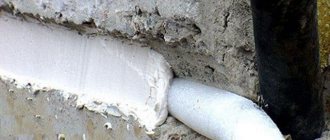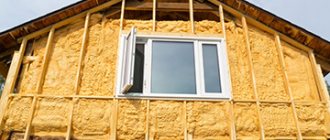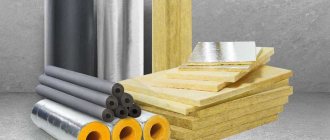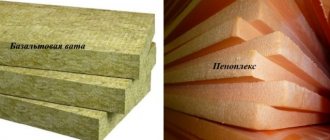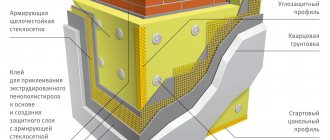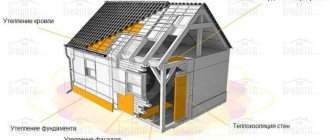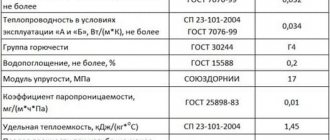Description of material
EPPS is extruded (or extruded) polystyrene foam. To put it simply - polystyrene foam, but not the usual pressed one, which easily disintegrates into small white balls, but more dense and durable. The composition of these materials is the same, but EPS has improved characteristics due to a special production method in which the prepared mass is extruded through the profiled holes of extruders. The cross-section of these holes gives the products a given shape.
Extruded polystyrene foam is used to produce slabs, substrates, shells for thermal insulation of pipes, and other products used in construction for insulation and insulation of various structures. As well as decorative elements.
Thermal insulation for sewer pipes Source fis.ru
The most popular and widespread product is slabs. They come in different thicknesses, smooth and corrugated, with smooth and stepped end faces. The latter ensure installation without through joints, which is very important for continuous insulation, as it eliminates cold bridges.
Each manufacturer sets its own sizes of slabs, but most often their width is 600 or 580 mm, and their length is 1000, 1200 or 2400 mm. The number of slabs in a package depends on their thickness.
For reference! In the catalogs of large online construction stores, this material is often listed under the name XPS. This abbreviation is accepted in European countries. Why it is used here is not entirely clear, because almost all products made from extruded polystyrene foam in our stores are represented by domestic brands.
Production technology
Most people not involved in the construction industry think of EPS as being the same foam plastic, but denser. In fact, there are many differences between pressed and extruded polystyrene foam, and they are associated with different production methods.
The raw material for the production of both materials is polystyrene Source dormakomplekt.ru
Before melting, crushed granulated polystyrene is mixed with chemicals that improve the characteristics of the finished product, making it more durable, less flammable, etc. Carbon dioxide or another foam-forming agent is introduced into the molten hot mass, which expands when the pressure and temperature are reduced. The foamed substance is fed into the extruder and squeezed out of it through a hole with the specified parameters.
In the case of slab production, it is rectangular and determines the thickness and width of the finished product. Solid EPS strips are sawed to length after cooling.
Line for the production of extruded plates Source masterplex.rf
Differences from polystyrene foam
EPS granules are much finer than those of polystyrene foam, since the material is exposed to very high temperatures and is formed under high pressure. Their size is tenths of a millimeter, while the diameter of the foam balls is several millimeters.
The dense, finely porous structure makes the material much more durable and resistant to stress. It is not so easy to break and almost impossible to crumble, since the adhesion between the granules is very strong. At the same time, the thermal conductivity and vapor permeability of extruded slabs is even lower than that of foam plastic.
Due to its porous structure, polystyrene foam is highly brittle and brittle Source ppu-prof.ru
Thanks to special fire retardant additives, they resist direct fire longer, and their dense structure does not particularly attract rodents and insects.
Advantages and disadvantages
Polystyrene is a polymer material, plastic, which is given special properties and structure through special processing. Therefore, speaking about extruded polystyrene, what it is and what characteristics it has, it is quite possible to say that it is plastic, but very light and friable. Accordingly, it has all the advantages of synthetic polymer materials. And there are many more advantages associated with the structural features. Let's list everything.
- Absolute moisture resistance - the material is not afraid of exposure to water, upon contact with it it does not collapse, does not rot, or becomes infected with mold.
- Low thermal conductivity, which is provided by sealed cells filled with air.
4 cm thick EPS can replace 85 cm of brickwork Source dy.spb.ru
- Extremely low water absorption: water does not penetrate into the EPS structure and therefore does not affect its thermal insulation properties.
- Durability is also associated with virtually zero water absorption, the absence of moisture in the material, which freezes and expands at sub-zero temperatures and causes internal destruction.
For reference! Water can penetrate inside only to a small depth, through damaged cells located on the surface. But this does not affect the properties of the insulation.
- Low vapor permeability makes EPS the most convenient heat insulator, without requiring additional protection from water vapor in the form of special films.
- Resistance to compressive loads, which increases in proportion to the density of the slabs.
- Low degree of thermal expansion due to changes in ambient temperature.
- Light weight - insulation, more than 90% consisting of air, practically does not increase the load on foundations and other foundations.
- Easy and all-season installation - EPS is easy to cut and attach, you can work with it at any temperature and humidity.
You can insulate buildings with polystyrene foam in any weather Source kraski-net.ru
See also: Catalog of companies that specialize in insulating houses
It is impossible not to mention the affordable price of this material, because of which it is often preferred to other insulation materials, ignoring the disadvantages. And EPPS also has them. Moreover, one and the same property is an undeniable advantage in one situation, and a disadvantage in another.
For example, low vapor permeability makes it practically unsuitable for insulating wooden houses, since polystyrene locks moisture in the wood and prevents condensation from evaporating. Which leads to wooden structures getting wet, rotting and gradual destruction.
The second important disadvantage is the release of substances harmful and dangerous to life and health from the material when it is heated above 70 degrees. By itself, it is considered low-flammable, since when exposed to fire it is difficult to ignite and almost does not burn. But it melts with the formation of toxic smoke, and it is this, and not fire, that is the more common cause of death in fires.
Fire safety certificate EPPS Source tutteplo.ru
Being resistant to stress, extruded polystyrene foam is easily destroyed by certain chemicals of inorganic origin, which include:
- bitumen mastics;
- acetone;
- toluene;
- paints and adhesives containing inorganic solvents;
- petroleum oils;
- impregnation for wood.
Therefore, when waterproofing, painting and other work, you need to carefully monitor the composition of the materials used if they come into contact with the insulation.
Where is EPS used?
The material described is used in a variety of fields, but we are interested in what EPS is in construction. This is a universal thermal insulation material that is used to insulate almost all parts of buildings:
- walls;
- foundations and plinths;
- floors and ceilings;
- basements and undergrounds;
- roofs;
- blind areas.
It is recommended to insulate EPS walls from the outside or use it as an intermediate layer when laying walls made of bricks and blocks.
Insulated brickwork Source bitrix24.ru
For external wall insulation, both ordinary EPS boards are used, which are then covered with plaster or a curtain wall, as well as decorative sandwich panels that do not require finishing.
It is important! If the house is insulated from the inside with polystyrene foam boards, it is necessary to take into account their low vapor permeability and consider a competent ventilation system. Otherwise, the indoor air will be humid, which will lead to mold.
In addition to insulating the main structural elements of buildings, slabs and other products made from EPS are used for thermal insulation of above-ground and underground pipelines, wells, septic tanks, caissons, cellars, and heated greenhouses. This material is laid on a rough base when installing a heated water floor, and is used as permanent formwork in the construction of foundations and walls.
Thermal insulation substrate for heated floors made of polystyrene foam Source fis.ru
Areas of use
Excellent thermal insulation and sound insulation properties, ease of processing and processing, as well as affordable cost make polystyrene foam a common material for many areas of human activity. Expanded polystyrene is often used for packaging goods, equipment, and food products. It is also used to produce disposable tableware, energy absorbers in the automotive industry, and even large outdoor advertising.
Expanded polystyrene is often used for thermal insulation of refrigeration equipment in industry due to the threat of dust. Expanded polystyrene is also used in thermal insulation of road surfaces. You can even make beehives from it!
The described material is widely used and used in construction - it is used as a structural and thermal insulation material. Most often, external insulation of private houses, apartment buildings or even industrial premises is carried out. Due to some characteristics of the material, it is not suitable for internal insulation (although such use is possible if certain technical requirements are met). Due to the fact that this building material is easy to install, even non-professional builders can use it for private construction or insulation of buildings.
Insulation of a private house with polystyrene foam
How to choose EPS insulation
The main parameters by which the material is selected are the density, size and configuration of the slabs.
Technical specifications
The density of polystyrene foam is an important criterion for selection. The larger it is, the stronger the slab and the greater the load it can withstand without deforming. Products with the highest density are even used in the construction of roads and runways.
The bulk of such products for universal use have a density from 25 to 45 kg/m3; in the marking it is indicated by the corresponding numbers. But there are products of both higher and lower brands. The higher the expected load on the insulated base, the greater this indicator should be.
For example, for insulation of plinths and foundations it is better to choose material of grade 35-40 and higher, but for roofs 25 is sufficient.
Selection rules
Polystyrene insulation is a popular and modern building material. Therefore, manufacturers do not miss the opportunity to make money on it. Dozens of types of insulation are sold on the market . How to choose the best polystyrene foam insulation?
- Pay attention to the brand of material. A good indicator is 40, you can buy less, but not 25, since this is considered the lowest quality.
- An important stage of selection is testing the technology. When choosing any products, you should adhere to GOST. There is no need to take risks and take insulation made using the manufacturer’s own technology, because the indicators may be much lower than the standard ones. For example, the PBS-S-40 brand may have a density of 28 instead of the stated 40 kg per cubic meter. As a last resort, ask for certificates that indicate the exact characteristics.
- Before buying a large batch, first buy one sheet and break off a small piece. The fault should form smoothly with regular polyhedra. The presence of large balls and irregularities indicates low quality of the material.
- Popular and already proven companies include: BASF, Polimeri Europa, Nova Styrochem, Chemicals and domestic ones - Technonikol and Penoplex.
Despite all the shortcomings and the difficult choice of insulation, expanded polystyrene is used in the construction of four out of five houses. Most construction companies trust him . If you take all precautions and follow technology, your home will be provided with heat for 30 years or more.
Video description
Since not all manufacturers indicate this parameter, you need to be able to determine it yourself. How to do this is shown in the video:
The quality of products also varies and depends on the manufacturer’s compliance with manufacturing technology. Some introduce harmful additives into raw materials or do not use recommended components. Sometimes ordinary polystyrene foam is sold under the guise of EPS. To be sure of quality, you should buy certified products manufactured not according to the manufacturer’s technical specifications, but according to GOST.
Advice! You can verify good quality by performing a simple test. You need to break off a piece of material and inspect the fracture site - small regular polyhedra should be visible on it, not balls.
Depending on the place of application, choose slabs with a stepped edge or a corrugated surface, which facilitates the application of a plaster layer on it.
Installation features
Knowing why extruded foam is needed, what it is and what positive characteristics it has is completely insufficient if you decide to install it yourself. The method of fastening depends on the type of insulated surface.
On the floor and blind area
When insulating horizontal surfaces, polystyrene boards do not require fastening. They are laid on a leveled surface - a floor slab or a sand cushion. When installing an insulated blind area or concrete screed, it is recommended to reinforce the concrete layer on top of the insulation with steel mesh.
If the insulation of a wooden floor is carried out followed by the laying of laminate, linoleum and other finishing coatings, then a wooden frame made of bars is first installed on the base, and EPS boards are laid between them. Sheets of plywood or OSB are fixed to the frame.
All joints and seams are filled with foam Source tetrapilon.ru
On the walls
EPS can be attached to vertical surfaces in different ways.
- Gluing.
The slabs can be glued to mineral substrates - to smooth walls made of brick, concrete, building blocks using special adhesives. Many manufacturers of extruded polystyrene foam also produce glue for their installation. In particular, TechnoNIKOL and Penoplex have them. But in construction stores you can find adhesive mixtures of other brands.
Facade insulation with polystyrene
Foaming polystyrene can be mounted on the façade in several ways. Thus, there is a traditional way of insulating building facades by gluing polystyrene boards on them, followed by putty passed through special fiberglass.
In addition to this method, experts resort to using a type of material such as impact-resistant polystyrene. This type of polystyrene boards is characterized by increased resistance to mechanical damage. In addition, such slabs are simply mounted on the facade wall, and the process of priming and putty can be carried out before their installation. It should be noted that façade polystyrene boards are subsequently finished in the form of cladding or painting.
Before starting work on finishing the façade of a house, most developers confidently say “I’ll buy polystyrene,” but they often have a problem: where can I buy foam polystyrene? In fact, such questions should not arise today, since this material is in great demand, and specialized construction supermarkets sell it. One of the leading manufacturers offers products under the Penoplex brand.
Along with the common foamed polystyrene, extruded polystyrene is also relevant, obtained by mixing material granules at high temperatures, followed by separation from the extruder and the addition of a foaming element. Due to its extraordinary structure, this type of polystyrene is characterized by stable thermal insulation and thermal conductivity characteristics. As a rule, it is used in combination with plaster, concrete and other cement mixtures.
Sales of polystyrene
Polystyrene is sold in granules - it is an environmentally friendly material with a high degree of thermal insulation and sound insulation. In construction it is used as insulation for: interfloor ceilings; impact-resistant floors; floors for industrial purposes, intended for moving vehicles; roofs with a maximum angle slope of up to 40 degrees.
Polystyrene, the price of which largely depends on the equipment used, is available for free sale. Any developer who plans to carry out insulation processes of varying complexity can buy polystyrene. Plastic made from this material is usually sold as finished products. At the same time, its installation should only be carried out by specialists, since one should not forget that the material is not particularly durable and is also highly flammable.
It is not recommended to hit polystyrene sheets with heavy objects or even with your fist. Environmentally, the material is recognized as completely safe, it can be safely used in residential premises, even sanitary standards allow this.
Video description
This video shows how to properly attach insulation to Ceresit CT 83 adhesive:
- Fastening with dowels.
This method is more economical and is used on uneven substrates, as well as on wooden surfaces. Plastic dowels with a large head hold light insulation well, a few pieces per slab are enough. Typically, fasteners are installed in the corners and in the center.
- Combined method.
If the walls are leveled with cement plaster, EPS boards can be glued onto a still fresh mortar and additionally secured with dowels.
- Frame method.
It is used for insulating walls under a suspended ventilated façade. The slabs are placed between the wooden frame guides in the same way as is done when insulating the floor. If the frame is metal, they are mounted on hangers fixed to the wall, and only then the profiles are installed.
Insulation of EPPS facade for finishing with siding Source 918747.ru
Video description
Watch a video about roof insulation over solid flooring:
On the formwork
To make permanent formwork from extruded polystyrene foam slabs, you will need special plastic ties with which the opposite walls of the formwork are fastened to each other and fixed at a certain distance.
The design of the ties allows you to change this distance and has special sockets for fixing the reinforcement cage bars.
Mounted formwork with a steel frame Source homemasters.ru
How to cut EPS
When carrying out thermal insulation work, EPS boards often have to be cut, cutting out pieces of the desired shape and size. Since the material is quite soft, this can be done with a knife, the main thing is that its blade is very sharp, durable and thin, otherwise the material will crumble.
Advice! To get rid of the strong squeaking noise that accompanies cutting, the knife blade can be periodically moistened with machine oil.
Another suitable tool for cutting is an angle grinder (simply an angle grinder) with a metal disc. The thinner it is, the less debris and dust will be generated, and the cleaner the cut will be.
There are also special tools for cutting foam plastic that work on the principle of thermal cutting - special machines and “hot knives”.
Thermal cutter for polystyrene foam Source allegroimg.com
It makes no sense to buy such equipment for one-time use, especially since a cutting machine can be made with your own hands from nichrome wire stretched between two driven nails. To make the wire glow, the nails are connected to a transformer and voltage is applied to them.
It is important! The thermal method of cutting polystyrene foam can only be used in the fresh air or when using personal protective equipment such as a respirator or gas mask, since when it is heated, toxic substances are released that can be harmful to health.
Homemade machine option Source pochini.guru
Main disadvantages
Now let's look at the problems that we encounter when using this insulation. It is easily exposed to direct sunlight , under their pressure its density weakens and becomes unstable to weather conditions.
- Many people believe that the thicker the insulation layer, the warmer the house. Cold air penetrating between the plates will cause disturbances: waves and cracks. European standard - 3.5 cm thick. With such calculations, heat is well retained, and in the event of a fire, the risk of poisoning from harmful chemicals released will be reduced .
- Another disadvantage is the complete lack of sound insulation. Insulation is completely unable to insulate a room. You can increase the number of layers, but you still won’t achieve a sufficient result. For sound insulation it is better to use another material.
- During the construction phase (more precisely, after the installation of polystyrene foam), it releases the harmful chemical styrene.
- If you heat it to 75 degrees, vapors are released: ethylbenzene, toluene, carbon monoxide and benzene, which will harm the human body. Manufacturers often try to refute this fact.
- Even the best quality insulation can catch fire sooner or later. This is confirmed by the assignment of G3 and G4 markings by GOST 30244−94 of the Russian Federation. Therefore, do not believe it when, when advertising polystyrene foam, they call it fireproof. Moreover, when melting, the smoke produced is so thick that you can’t see your hands. To summarize, calling polystyrene foam “fireproof” means its resistance to fire itself, but not combustion. However, the insulation is never used as a finishing coating for the walls; it is additionally covered with facing structures, which prevents the foam from wearing out.
Briefly about the main thing
We can say about the EPS board that it is a universal thermal insulation material for all structural elements of buildings. It retains heat perfectly, insulates noise, is not afraid of water and weighs almost nothing. But its scope of application is limited by two factors: toxicity when heated and very low vapor permeability, due to which expanded polystyrene is not recommended for insulating wooden houses. The quality of the material depends on strict adherence to the production technology regulated by GOST. And its installation is quite simple and accessible even for beginners in construction.
Ratings 0
Disadvantages of polystyrene foam.
But there are also disadvantages to using this material. Firstly, polystyrene foam is flammable, no matter what the manufacturers of this material claim. It consists entirely of chemicals and, when burned, releases harmful toxins; even when heated above 30 degrees, the oxidation process begins. The case of poisoning people when burning polystyrene foam is known to everyone: in 2009, a large number of people suffocated at the Lame Horse club, although they did not use extruded polystyrene foam, but packaging foam of much worse quality.
High-quality and protected polystyrene foam has a service life of more than 30 years. For facade insulation, the best choice would be PSB-S - self-extinguishing polystyrene foam no lower than grade 40. Despite all the disadvantages, this is a very effective and inexpensive insulation material, but, no matter how the manufacturers say, it is not worth insulating interior spaces.
